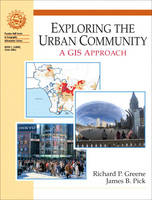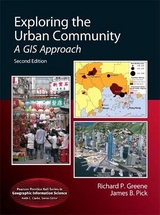
Exploring the Urban Community
Pearson (Verlag)
978-0-13-017576-2 (ISBN)
- Titel erscheint in neuer Auflage
- Artikel merken
For courses in Urban Geography and Urban Planning.
This book covers all the important traditional urban geography topics such as urban spatial structure, central place theory, neighborhood change, and industrial locations analysis, and also expands upon these to include contemporary topics such as global cities, gender, activism, technology, postmodernism, trans-nationalism, sexuality, and environmental justice. In addition to broad and very current coverage, this contemporary, well-written treatment of urban geography features strong integration of GIS technologies, and thus gives instructors the option to utilize geographic information systems in their teaching. The integration of GIS benefits students by its use as an analytic tool to understand urban phenomenon, and by its importance as a skill for future jobs. The GIS coverage provides a valuable tool for professors to use to teach and engage students in active learning.
(NOTE: Each chapter begins with an Introduction and concludes with a Summary and GIS Exercise.)
1. Urban Geography and the Spatial Display of Urban Environments
The Study of Urban Geography
Urban Geography as a Discipline: Its Importance
An International View to Urban Geography
Analyzing An Urban Issue: Sunbelt Growth
The Chicago School and its Link to Urban Geography
The LA School of Urban Studies
Data and Spatial Analysis in Urban Geography
Alternative Approaches to Urban Geography
Geographic Information Systems
Urban Analysis Using GIS
The Approach of the Book
Summary
An Introduction to GIS and Spatial Analysis Principles
GIS Exercise: Population Growth in the Sunbelt versus the Rustbelt
2. The Dynamics of Cities
Introduction
Economic Change
Demographic Change
Social Change and Socioeconomic Polarization
Megacity Profile of Chicago
Megacity Profile of Los Angeles
Megacity Profile of Mexico City
Analyzing an Urban Issue: Changes in Population Ranks Among Areas of Chicago and Los Angeles
Summary
GIS Exercise: Rank Mobility Index Applied to Chicago and Los Angeles
3. Defining the Metropolis
Urban and City Concepts and Process
Definitions of City, Urban Area and Metropolitan Area
International Comparisons
City Size Distributions and Census Definitions
City as Municipality
City as a Built-Up Area
City as Metropolis
Analyzing an Urban Issue: Metropolitan Definition
Other Approaches to Defining the Metropolis: the Case of Mexico
Summary
GIS Exercise: Metropolitan Area Definitions for Springfield, Missouri: Calculating U.S. Census Concepts
4. The Internal Structure of Cities
Introduction
Classic Urban Development Models
Concentric Zone Model
Sector Model
Multiple Nuclei Model
Structuralism and Postmodernism: Alternative Perspectives
Have the Classic Models Stood the Test of Time?
Analyzing an Urban Issue
Chicago and Los Angeles Urban Development Patterns
Mexico City Urban Density Patterns: Density Gradients
Convergence and Divergence from the Classic Models: The Case of Chicago
Conclusion
GIS Exercise: Population Density Mapping Comparisons for Chicago, Los Angeles, and Mexico City
5. Systems of Cities
Introduction
Central Place Theory
Analyzing an Urban Issue: Central Places Hierarchy in Snohomish County, Washington
Contemporary Central-Place Research and the Gravity Model
City Size Distributions
Evolution of the American Urban System
Global Cities
Contemporary Research on Urban Systems
Summary
GIS Exercise: Central Place Provisioning in Snohomish County, Washington
6. Neighborhoods
Introduction
Concept of Neighborhood
Social Life in the City/Urbanism as a Way of Life
Gated Communities
Change in Neighborhood Racial Composition
Analyzing an Urban Issue: Neighborhood Transitions
Gentrification
Neighborhood Activism
Conclusion
GIS Exercise: Neighborhood Change in St. Louis: Analysis with Transition Techniques
7. Migration and Residential Mobility
Introduction
Concepts and Factors of Migration
Models of Migration
Behavioral Processes of Residential Mobility
Directional Bias in Moving
Analyzing an Urban Issue: Accessibility Index in Los Angeles
Migration Patterns and Trends in the United States and Australia
International Immigration
Transnational Identities
Case of Immigration Impact on a City: Dominicans in New York City
Rural-Urban Migration and China’s Cities
Conclusion
GIS Exercise: Analysis of Population Potential in Los Angeles
8. Race, Ethnicity, Gender, and Poverty
Ethnic Enclaves, Social and Community Identity
Concepts and Processes of Race, Ethnicity, and Segregation. Importance of scale. Centrographic method.
Analyzing an Urban Issue: Segregation
Cities and Immigrants
Waves of Immigration in the U.S.
Racial Segregation
Emerging Ethnic Hot Spots in the Suburbs
Gender
Poverty and Its Measurement
Poverty in the U.S. and Its Cities
Extreme Poverty: the Ghetto
Another Type of Poverty: Colonias along the Mexican Border
Summary
GIS Exercise: Ethnic Change in St. Louis using a Centrographic Method
9. Industrial Location
Introduction
Industrial Classification and Location Concepts and Processes
Manufacturing Location Theory and Agglomeration
Least-Cost Theory
Agglomeration Economies
Intra-Metropolitan Industrial Location Theories
Analyzing an Urban Issue: Intra-Urban Industrial Location
Location Quotient
A Comparison of Professional Services and Manufacturing Spatial Patterns
Industry Location Trends Across Cities
High Technology Industry
Maquiladora Industry on the Mexico/U.S. Border: A Unique Manufacturing Region
Consumer Services and Cities
Retail Location Patterns within Cities
The Consumer Cities Hypothesis
U.S.-Mexico Twin Cities Consumer Interaction on the Border
The Geography of Producer Services
Summary
GIS Exercise: Industry Location with Location Quotient Analysis in Los Angeles
10. Urban Core and Edge City Contrasts
Introduction
Central City Decline
Urban Sprawl
Trends in Urban Development Rates
Analyzing an Urban Issue: Urban Sprawl, Its Measurement, and Its Impacts
Sprawl Outside the United States: the Case of Sydney, Australia
Transportation and Urban Sprawl
Edge Cities
Smart Growth
Portland’s Growth Boundary
Summary
GIS Exercise: Land Use Conversion in Chicago and Los Angeles
11. Environmental Problems
Introduction
Concepts and Processes of Urban Environment
Land Use
Water Resources
Urban Flooding
Solid Wastes
Energy
Air Pollution
Analyzing an Urban Issue: Air Pollution in Mexico City
Environmental Justice and Preserving the Natural Environment
Conclusion
GIS Exercise: Spatial Comparison of Air Pollutants in Mexico City
12. Urban and Regional Planning
Introduction
Antecedents
Garden Cities
Progressive Movement and Zoning
Modern Planning: Metropolitan and Regional Planning
Growth Management
Analyzing an Urban Issue: Land Use Planning
Planning for Smart Growth
Case Study of Urban Planning for Irvine, California
Urban Governance and Urban Politics
Technology and Its Influence on the City
Other Topics in Urban Planning
Viable Downtowns
Open Space Planning
Planning Challenges in the Developing World
Conclusion
GIS Exercise: Integrated Spatial Analysis of Land Use Planning in Western Chicago
| Erscheint lt. Verlag | 12.5.2005 |
|---|---|
| Sprache | englisch |
| Maße | 284 x 216 mm |
| Gewicht | 1251 g |
| Themenwelt | Naturwissenschaften ► Geowissenschaften ► Geografie / Kartografie |
| ISBN-10 | 0-13-017576-5 / 0130175765 |
| ISBN-13 | 978-0-13-017576-2 / 9780130175762 |
| Zustand | Neuware |
| Haben Sie eine Frage zum Produkt? |
aus dem Bereich



